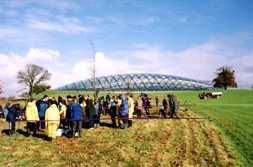The dome containing the National Botanic Gardens of Wales. It is situated just off the A48 near Porthyrhyd, between Cross Hands and Carmarthen. The new National Botanic Garden of Wales has a rich legacy on which to build.
The vision of William Wilkins - the instigator of this £45 million millennium project - complements the vision of William Paxton the man who, two hundred years ago, turned the Middleton Hall estate into a vast pleasure garden. It was under Paxton`s instructions that the landscape which we see today was sculpted and according to Paxton`s orders that the necklace of lakes which surrounds the main body of the estate was formed.
William Paxton came to Wales in 1785, after thirty years of travelling the world, bringing with him a taste for the exotic. He could not have known when he set sail from England some thirty years earlier as a `captain`s boy` that he would return having made his fortune and secured his social standing. With the money and privilege to be able to indulge his passions, he bought Middleton Hall and its estate, and in 1789 he set about enlarging and enriching the five hundred acre park.
Although it was in Paxton`s interests to make his estate produce an acceptable annual revenue this was not his first consideration. He intended to develop the estate into a home that would do him credit and provide amusement for him and his young family.
His choice of engineer James Grier as his estate manager confirms this. His skills must have played a large part in the creation of the artificial lakes and the design of the intricate water management system that distinguished Paxton`s park in its heyday. Water played an important role in Paxton`s scheme. It may be that he had been insprired by the Mughal gardens which he had seen in India. If so he adapted his ideas well to the landscape and climate of South Wales where water could be used to create beautiful lakes stocked with fish. Dams were created and bridges and sluices were built along with two cascades.
Another man of great talents was invited by Paxton to contribute to his plans for Middleton Hall. Architect Samuel Pepys Cockerell designed a new mansion, sited to take advantage of the magnificent views over the Towy valley.
The third man employed by William Paxton to help realise his dreams was Samuel Lapidge, one of Lancelot `Capability`Brown`s surveyors. Lapidge inherited Brown`s practice and continued in his style. The idea for the double walled garden towards the north of the estate is likely to have been Lapidge`s. Paxton had probably been interested in gardening long before he bought Middleton Hall. It was a popular occupation among the Europeans in Bengal where he had lived. It was not uncommon for enthusiasts such as him to import seeds and seedlings from different parts of Asia, the east coast of Africa and Europe in order to test the possibilities of growing different plants in Bengali soil.
Paxton and Grier combined this interest in horticulture with their technical expertise to explore the use of piped water throughout the estate. A pattern of clay pipes appears to have been used to heat the hothouse. Oranges, melons and grapes were grown in the garden and it is probable that more delicate plants were also grown using this elaborate heating system.
Paxton, like many of his time, believed in the healing power of natural spring water and a bath house was built with the discovery of chalybeate springs in the park. Paxton was keen to encourage `the common people` to take the waters and he extended the pipes to conduct water from the spring to the outside of the wall surrounding the park. Newly-wealthy and public-spirited, Paxton aspired to a political career in Carmarthenshire. He stood as a Whig in the 1802 election. Despite his lavish spending he was outdistanced by 139 votes. The bill Paxton was presented with after the election was enormous. Among the items were 11,070 breakfasts, 36, 901 dinners and 25,275 gallons of ale.
Paxton had lost his heart to Carmarthenshire but there were not enough Carmarthenshire hearts won to secure him the political career he desired. His Scottish birth remained a handicap and his `Indian` purse proved the envy of his neighbours. It is said that Paxton`s election promise to the voters was to build a much needed bridge over the Towy. Instead, it is said, with the money and the materials he had put aside he built Paxton`s Tower. The `folly` is one of the most conspicuous landmarks on overlooking the Towy Valley. Whatever the true reason for its construction the `folly` was dedicated by Paxton to Nelson after his death at Trafalgar.
After Paxton`s death in 1824 the Middleton Hall estate was put up for sale. It passed through the hands of three families before, in 1931, the mansion was gutted by fire. Twenty years later the walls were pulled down and for some years this was the end of the story of Middleton Hall and its parkland. The site was bought by Carmarthen County Council and leased to young farmers hoping to make their way into an agricultural career.
The artificial lakes drained away with the ruin of the dams and sluices. Paxton`s bath-houses were forgotten and it needed an experienced and discerning eye to find the underlying structure of Paxton`s park and to imagine the former charm and beauty.
It was the artist William Wilkins who first came up with the idea of building a botanic garden on the site of Paxton`s park and although the new National Botanic Garden of Wales is much more than a reconstruction of Paxton`s creation it is on a scale of which William Paxton could be proud.
Greater detail can be found on the following Internet link:
http://www.leisurebritain.co.uk
In the Enter County box, scroll down to Carmarthenshire where Middelton Hall will be found.
Date this page last updated: October 1, 2010

